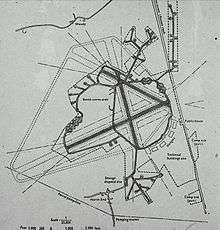Class A airfield

Class A airfields were military installations originally built for the Royal Air Force in the Second World War. Several were transferred to the U.S. Eighth Air Force for use as heavy bomber bases. The term Class 'A' came about because quite often, the resultant aerial shot of the crossed runways would look like the letter A.[1]
Design
Class A layouts were constructed to specifications set by the British Air Ministry in August 1942, the main feature of which was a set of three converging strips, each containing a concrete runway for takeoffs and landings, optimally placed at 60 degree angles to each other in a triangular pattern.[2] The longest strip was designated the main strip and aligned southwest to northeast wherever possible, this being chosen to allow aircraft to takeoff and land into the prevailing winds. The other two runways were to allow safe take off and landing when the wind was blowing from other directions. The primary consideration was for operational safety for any type of aircraft then in operation or under development.
The runways were connected by taxiways called a perimeter track (peri-track), of a standard width of 50 feet (15 m). However, certain stations that were designated to be fighter bases sometimes had a narrower Peri-Track, such as RAF Coltishall, whose peri-tracks measured 40 feet (12 m) across.[3] A 30 ft (9.1 m) area was cleared and leveled on either side of the perimeter track. Class A specifications for taxiways set a minimum curve radius of 150 feet (46 m) measured from the centre line for angles greater than 60 degrees and 200 feet (61 m)) for angles less than 60 degrees. Perimeter track gradients could not exceed 1 in 40 in any direction, and no building could be placed closer than 150 feet (46 m)from the edge of the track.
Areas called hardstands were placed along the perimeter track, made of concrete, with their centres at least 150 feet (46 m) from the edge of the track and the edges of each hardstand separated from each other and from the funnels by a minimum of 150 feet (46 m). The purpose of the hardstands was to allow aircraft to be dispersed some distance from each other so that an air attack on the airfield would be less likely to destroy all the aircraft at once. Dispersal also minimised the chance of collateral damage to other aircraft should an accident occur whilst bombing-up. Hardstands were either of the Frying-Pan or Spectacle Loop type, with the Spectacle type being the easiest in which manoeuvre aircraft.[4]

The strips were 600 feet (180 m) in width, cleared, graded and surfaced with turf. A concrete runway 150 feet (46 m) in width was centred on the strip, with a length of 4,000 yards (3,700 m) for the main strip and 1,400 yards (1,300 m) for the secondary strips.[1] On each side of the strip the field was cleared of obstructions and leveled an additional 300 feet (91 m). Gradients for the strips were a maximum 1 in 80 longitudinally and 1 in 60 transversely. In addition, an area at the end of each runway was cleared of obstructions at an angle of fifteen degrees outward from each side on a rising imaginary plane of 1 in 50 to provide a flightway called a funnel.
Construction
The material needs for building runways suitable for heavy bombers were approximately 18,000 tons of dry cement and 90,000 tons of aggregate. Expected stress factors of 2,000 pounds per square inch led to runway thicknesses of six to nine inches of concrete slab laid on a hardcore base, covered with a layer of asphalt. In areas where there was no natural rock, such as East Anglia, stone had to be imported for the hardcore.

Operational use
Nine airfields (Alconbury, Bassingbourn, Chelveston, Grafton Underwood, Kimbolton, Molesworth, Podington, Polebrook, and Thurleigh) were allotted to the Eighth Air Force but had been completed prior to the Class A standard for runway lengths. These were brought to Class A standards in 1942 and early 1943 by extending their runways, repositioning their perimeter tracks, and adding additional hardstands.
Class A airfields were also characterized by standardized technical site requirements for repair, maintenance and storage of aircraft. Two T-2 type metal hangars (240 feet long by 115 feet wide by 29 feet high) were the standard for most airfields, although a few pre-1942 bases had three T-2 hangars and Thurleigh had four. Three bases (Chelveston, Molesworth, and Polebrook) also had a J Type brick-and-metal hangar (300' X 151') in addition to a pair of T2's, and Bassingbourn, which had been a pre-war RAF bomber station, had four C type brick hangars measuring 300 by 152 feet
Post-war motorsport use
With the end of World War II and the resurgence of the sport of motor racing several former airfields were used as race tracks, including Silverstone, Castle Combe, Goodwood and Thruxton.
Most race tracks on former airfields use the encircling perimeter track, although the main straight at Snetterton is laid down on a secondary runway,[5] and the main runway is used at Santa Pod Raceway (formerly RAF Podington) for drag racing.[6]
See also
References
Citations
- 1 2 Smith 1999, p. 53.
- ↑ Francis, Paul; Flagg, Richard; Crisp, Graham. "Nine Thousand Miles of Concrete A review of Second World War temporary airfields in England" (PDF). Historic England. p. 6. Retrieved 19 September 2016.
- ↑ "RAF Coltishall Historical Appraisal" (PDF). Heritage.Norfolk.gov.uk. pp. 13–14. Retrieved 19 September 2016.
- ↑ Halpenny 1981, p. 11.
- ↑ "Historical Snippet Part 1 - 2 Aug 2013". Snetterton Circuit. Retrieved 5 October 2016.
- ↑ "Podington". Airfields of Britain Conservation Trust. Retrieved 5 October 2016.
Bibliography
- Freeman, Roger A. (1991). The Mighty Eighth War Manual. ISBN 0-87938-513-8.
- Halpenny, Bruce. (1981). Action Stations 2; Military airfields of Lincolnshire and East Midlands. ISBN 0-85059-484-7.
- Smith, Graham. (1999). Hertfordshire & Bedfordshire airfields in the Second World War. ISBN 1-85306-585-4.